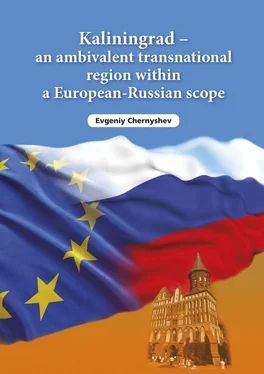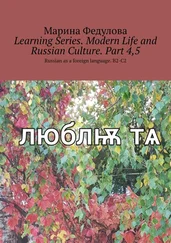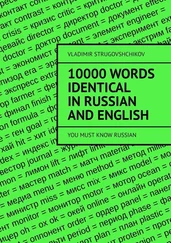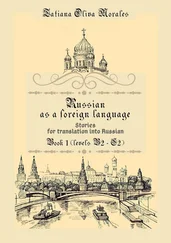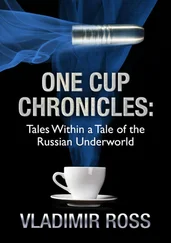1 ...6 7 8 10 11 12 ...26 Martinez 82 82 Martinez, Oscar: Border people: Life and society in the U. S. – Mexico borderlands. Tucson 1994, p. 6—10.
based his concept of the borderlands milieu , on the study of the US-Mexico border. Such «milieu» can be affected by many cross-border and national factors, which can be grouped in such a way as to produce a typology of borderlands interaction. In the assumption of the concept of Matinez, depending on the political conjuncture the Kaliningrad region as borderland can be attributed to two groups. First, coexistent borderland is present when neighbouring states reduce tensions to a manageable level, and modest cross-border interaction occurs. Second is interdependent borderland, which involves a symbiotic relationship between border regions in adjacent countries. There is a binational economic, social and cultural system at work between the two border regions, and perhaps between their states, but a number of policies retain state separation at the boundary 83 83 Donnan, Hastings; Wilson, Thomas: Op. cit., p. 51.
. The existence of binational economic, social and cultural system at work on the level of the two border regions allows us to stress, that the Kaliningrad region nowadays can move towards the tendency of an interdependent borderland.
In the issue, anthropological research on border cultures contributes to our knowledge of identity formation 84 84 Ibid, p.13.
. Taking into account the concept of Martinez, it is worth to note that the Kaliningrad borderland is bears the imprint of ambivalence, which is reflected, cultivated and maintained in the mindsets of young Kaliningradians. Because of their transborder and transnational linkages, these border cultures are often treated suspiciously by states and their agents, many of whom believe in the traditional view of the convergence of state, nation, identity and territory 85 85 Ibid, p. 53.
. As we know the stronger rulers belief was that strict control of the frontier was essential to the maintenance of their power 86 86 Anderson, Malcolm: Frontiers: territory and State Formation in the Modern World. Oxford 1996, p. 5.
. The above is manifested in the Kaliningrad regional culture, forms it and affects the everyday practices.
It is certainly a commonplace in the interdisciplinary field of border studies that the border can only be conceptualized as being shaped and produced by a multiplicity of actors, movements and discourses. But most of these studies still perceive the practices of doing borderwork and making borders as «acts and techniques of state» 87 87 Casas-Cortes, Maribel; Cobarrubias, Sebastian; De Genova, Nicholas; Garelli, Glenda; Grappi, Giorgio; Heller, Charles; Hess, Sabine; Kasparek, Bernd; Mezzadra, Sandro and al.: New keywords: migration and borders. In: Cultural studies. Vol. 29, Issue 1 (2015), p. 15.
, more specifically state political institutions. Then from the empirical point, the politicization of cultural identity requires people to react against their own felt disadvantage and denigration, as well as occurring in characteristic economic and political circumstances 88 88 Cohen, Anthony: Boundaries and boundary-consciousness: politicizing cultural identity. In: Anderson, Malcolm; Bort, Eberhard (ed.): The frontiers of Europe. London 1998, p. 31.
.
During my empirical study I asked my respondents about the format of interaction within political, economic and cultural dimensions in the space of the borderland region and whether it is legitimate to talk about the hierarchy or the interdependence of these measurements. I have collected very different answers, which made the basis of empirical research in the light of the idea that the culture is but one element in the definition and reproduction of a political system.
I consider the point of Strassoldo relevant who concluded that the ambivalence of border life is a defining feature of border societies in several respects 89 89 Strassoldo, Raimondo: Boundaries in sociological theory; A reassessment. In: Strassoldo, Raimondo; Delli Zotti, G. (ed.): Cooperation and conflict in border areas. Milan 1982, p. 152.
. Border people may demonstrate ambiguous identities because economic, cultural and linguistic factors pull them in two directions. They are also pulled two ways politically, and may display only a weak identification with the nation-state in which they reside. This ambivalent border identity affects the role that border communities play in international cooperation and conflict 90 90 Strassoldo, Raimondo: Frontier regions: Future collaboration or conflict? In: West European politics. Vol. 5, no. 4, 1982.
. Everyday practice of young Kaliningradians and empirical research logically fall on this theoretical basis.
For Anderson, borders are both institutions and processes. Anderson also stresses that «borders are markers of identity, and have played a role in this century in making national identity the pre-eminent political identity of the modern state» 91 91 Donnan, Hastings; Wilson, Thomas: Borders: frontiers of identity, nation and state. Oxford 1999, p. 5.
.
The frontiers are markers of identity , in the twentieth century usually of national identity, although political identities may be larger or smaller than the «nation» state. Frontiers, in this sense, are part of political beliefs and myths about the unity of the people and sometimes myths about the «natural» unity of a territory 92 92 Anderson, Malcolm: Frontiers: territory and State Formation in the Modern World. Oxford 1996, p. 2.
. These «imagined communities», to use Anderson’s 93 93 Anderson, Benedict: Imagined communities: Reflections on the origin and spread of nationalism. London 1983.
phrase, are now a universal phenomenon and often have deep historical roots. These communities are defined by imagined boundaries, if we follow Cohen’s remark, that «where cultural difference was formerly underpinned also by structural boundaries, these have now given way to boundaries which inhere in the mind: symbolic boundaries» 94 94 Cohen, Anthony (ed.): Symbolizing Boundaries. Manchester 1986, p. 17.
. To accept this assumption, we must proceed from the fact that «human consciousness and social organization are profoundly conditioned by territory and frontiers» 95 95 Anderson, Malcolm: Op. cit., p. 189.
. I note the importance, of how Cohen estimates symbols as a resource for identity. According to his point of view they are «pragmatic devices which are invested with meaning through social process of one kind or another, they are potent resources in the arenas of politics and identity» 96 96 Cohen, Anthony: Boundaries and boundary-consciousness: politicizing cultural identity. In: Anderson, Malcolm; Bort, Eberhard (ed.): The frontiers of Europe. London 1998, p. 23.
.
I share the view, that in certain circumstances the frontier acquired a mythic significance in building nations and political identities, becoming, as Anderson signalized, the mythomoteur of a whole society 97 97 Anderson, Malcolm: Frontiers: territory and State Formation in the Modern World. Oxford 1996, p. 4.
.
For Barth 98 98 Barth, Fredrik: Ethnic groups and boundaries: the social organization of cultural difference. Long Grove 1998.
, ethnic groups are socially designed using individuals who adjust their cultural identity by emphasizing or underplaying it according to current context. Individuals can cross the boundaries between groups if they find it advantageous to do. Moreover they can maintain regular relations across them, but this does not affect the durability and stability of the boundaries themselves. Accordingly, «cultural emblems and differences are thus significant only in so far as they are socially effective, as an organizational device for articulating social relations» 99 99 Donnan, Hastings; Wilson, Thomas: Borders: frontiers of identity, nation and state. Oxford 1999, p. 21.
.
Читать дальше
